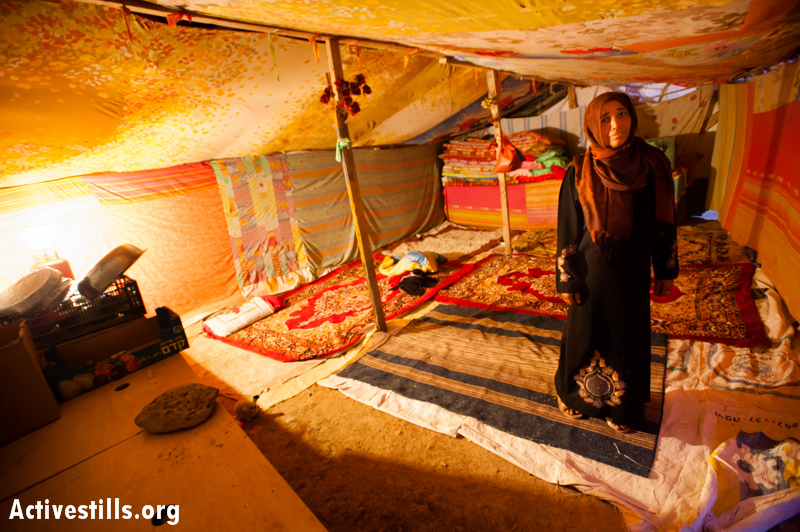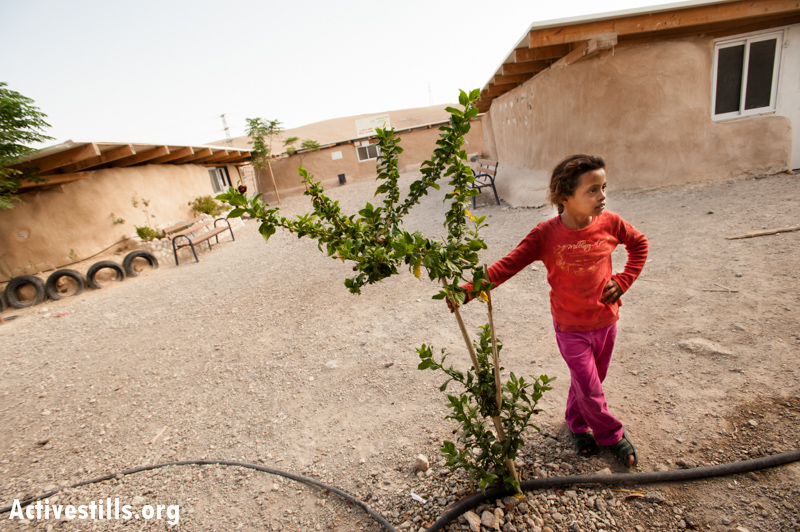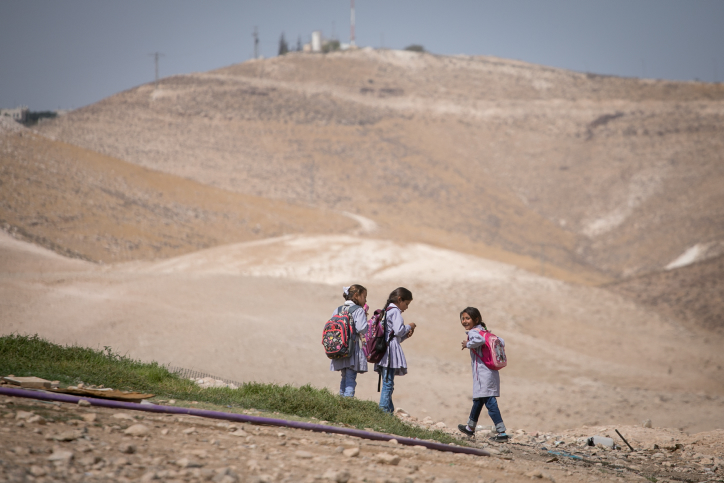The Palestinian residents of Khan al-Ahmar are facing the threat of expulsion from their homes in the West Bank. No matter how hard they tried to ingratiate themselves with their settler neighbors, nothing seemed to help.

Sukkot is a lovely holiday. For seven days we play pretend: building ornate sukkot tabernacles in the safety of our yards or on our balconies, and imagine transience. While we say blessings, the residents of the Bedouin village of Khan al-Ahmar will be biding their time.
Is there another way to awaken the Jewish-Israeli conscience, which instructs us to remember that the sukka was an integral part of our forefathers’ journey from slavery to freedom? That this is not so different from the dilapidated shacks that house the residents of Khan al-Ahmar, from which the state is trying to expel them? Will the fate of hundreds of people, children and elderly who live in deep poverty just a short drive away from the settlement of Kfar Adumim, be of any interest to us a moment before we go back to our daily routine after the holiday comes to an end?
The story of Khan al-Ahmar is depressing in its banality. The Jahalin Bedouin community who were forced to leave their land in the Negev Desert following the 1948 war and wandered to the Mishor Adumim area of the West Bank. Decades later, that area was designated “Area C,” under full Israeli military control; the Jahalin, then, turned into an obstacle to settlement expansion. As long as Bedouin communities in the area have been under Israel’s control, the state has refrained from providing them with minimal living conditions, including connecting them to water and electricity. In fact, Israel has done everything in its power to prevent the residents from taking their fate into their own hands.
The state does not seem to be satisfied with home demolitions, fines, and confiscating equipment — now it wants to evict the entire village. To where? To an area bordering on a giant landfill near Abu Dis, an area that the state itself has called a “ticking time bomb” due to the large methane deposits that have accumulated over the years. The master plan proposed by the residents of Khan al-Ahmar, along with Israeli planning rights NGO Bimkom, was rejected by the Civil Administration.
A symbolic struggle
One must see Khan al-Ahmar in order to understand the dire poverty in which the residents live. I joined Rabbi Yehiel Grenimann from Israeli NGO Rabbis for Human Rights, which has worked with Umm al-Hiran for many years. “There are two ways to arrive at the village,” he says as he parks the car. “One can take the long way through the tunnel below us, or you can cross the road here,” he points at Jerusalem-Ma’ale Adumim road. We take our chances and quickly cross the road.

On the way to our host, Eid Abu Khamis, I think about the similarities between Khan al-Ahmar and the hamlet of Susya, which is also under threat of expulsion. “The difference is that the resident of Susya own their land,” says Abu Khamis. “The land here originally belongs to the villagers of Anata, who gave us permission to live on their land.” The fact that Susya’s residents live on their own land does not seem to help them.
Like Susya, Khan al-Ahmar has become a kind of symbol, thanks in great part to the village’s flagship project: an ecological school established by the residents, with international aid. For many years, Bedouin communities in the area did not have a school, with children being forced to travel great distances to learn.
“Several children were run over on their way, and the girls wouldn’t be sent because of the distance. Over time we realized the children often leave for school, get tired on the way, and don’t go to school. In 1991 we submitted a request to build a school here, but the Civil Administration did not approve it,” he adds. Even their request for a bus that would transport the students to schools was rejected, as was a request to the Palestinian Authority for aid.
In the end, the residents decided to take matters into their own hands, and with the help of an Italian NGO that specializes in ecological structures, as well as local and international activists, they built a school from tires, mud, and clay. “Of course the Civil Administration immediately issued a stop-work order,” Abu Khamis recalls. “We divided ourselves up so that one group worked while the other kept an eye out to make sure no one from the Civil Administration would show up. And if they did show up, we would quickly dress up the activists in Bedouin garb, since they would deport the international activists while the Israelis could be arrested.”

Upon its completion in 2009, the Civil Administration issued a demolition order against the school. A short time later, the nearby settlements of Kfar Adumim, Alon, and Nofei Prat — along with settler NGO Regavim — petitioned the High Court, demanding that the state carry out the demolition orders against over 250 Bedouin structures in the area, including the school. “Over the summer, we were worried that they would take advantage of the fact that there were no children, and that they would come demolish,” says Rabbi Grenimann, “so we organized a summer camp to make sure there was constant presence in the village.” Meanwhile, the residents petitioned against the demolition orders. The state has declared its intention to remove the entire village, leading to the rejection of there settlers’ petition.
The school is still standing, for now. In the context of the neglect around us, it looks like a kind of wonder: colorful, well kept, with organized classrooms and a playground. “After we finished building the school, I went to the school at Kfar Adumim and said, ‘We are neighbors, we built a school. Let’s meet each other and maybe form a partnership,” says Abu Khamis. “They sent a delegation that praised us for our work. They seemed satisfied. After a week they went to the court and demanded that our school be demolished.” Abu Khamis worked for years on his bulldozer in Kfar Adumim. After the school was built, he lost his job there.
Parallel universe
Kfar Adumim is a mixed religious-secular community made up of less than 400 families. It has seven pre-schools for various ages, an elementary school, and a high school that takes pride in a meeting “that leads to an education that sees complexities, that invites students to engage with different views, with a different lifestyle and different customs. A high school graduate will develop a tolerant and complex way of thinking — there are many ‘others’ near here, and all of them have a place.” All of them, except Bedouin students.
The experience of driving inside Kfar Adumim following a visit to Khan al-Ahmar is close to surreal. Two kilometers separate the two, which seem to exist in parallel universes. After passing through the electric gate and the security guard who looks at us and decides that we can enter — perhaps due to the kippa on Rabbi Grenimann’s head, we enter the heart of settler bourgeoise.
Beautiful squares, red roofs, and a sign that leads to the settlement pool. How can anyone live here and still focus on a school made of mud and tires?

“It’s very easy to get angry at the hilltop youth,” says Grenimann, “but the residents here are far worse. They have much more power to do bad things, because they are considered normative. These are the people who legitimize the settlement enterprise — not the hilltop youth.” On the way back from a short visit to the Abu Dis waste site, where the stench makes it nearly impossible to breathe, Grenimann says “this is where compassion ends.”
The state’s announcement that it will expel the villagers of Khan al-Ahmar before mid-2018 means the village’s fate does not look good. The residents of Kfar Adumim, with their so-called progressive educational worldview, will get what they want, and the Bedouin children will lose not only their only school but their own homes. If Khan al-Ahmar’s residents are eventually moved to Abu Dis’ waste site, they are expected to suffer from similar health issues, including high rates of disease and death, that other Bedouin communities who were already transferred to the area face.
If no miracle occurs, next year when the settlers of Kfar Adumim sit in their decorated tents overlooking the beautiful view before them, the shacks of Khan al-Ahmar will no longer bother them. They’ll remember how their forefathers once sat in sukkas, as they left Egypt to become free people.
This post was first published in Hebrew on Local Call. Read it here.

